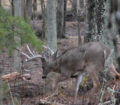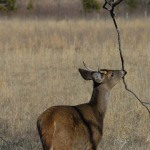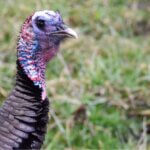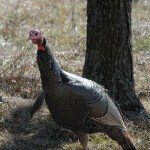John’s Note: The hunters who score deer year after year know the truth – you have to give Lady Luck a helping hand. Here’s how!
 Being in your tree stand 45 minutes to an hour before daylight is another important ingredient to deer-hunting success. But if you’ve ever been in a tree stand that early, you know there’s not really much you can do. On this day when I was hunting (see Day 1), I spent the first part of this morning catnapping or reading outdoor books on my Kindle. I didn’t sleep soundly, because I realized I’d have to wake up in a short time. But, I did rest. Then when the time arrived that I had to be alert, I would have all my senses ready.
Being in your tree stand 45 minutes to an hour before daylight is another important ingredient to deer-hunting success. But if you’ve ever been in a tree stand that early, you know there’s not really much you can do. On this day when I was hunting (see Day 1), I spent the first part of this morning catnapping or reading outdoor books on my Kindle. I didn’t sleep soundly, because I realized I’d have to wake up in a short time. But, I did rest. Then when the time arrived that I had to be alert, I would have all my senses ready.
Just as the sky began to gray to announce a new day, I stood in my tree stand. By standing, I knew I could turn to face the deer quieter with less motion than if I were sitting. One of the worst positions a hunter can get caught in is to be sitting when a deer walks up behind him. At that point, if the hunter turns around to face the deer, more than likely he’ll spook the animal and not get a shot. If he waits for the deer to walk in front of him, there’s a 75-percent chance that the deer will walk away without the hunter’s ever getting a shot. I’ve learned from some of the best whitetail hunters in the nation that, “When you’re hunting, you’re standing. And when you’re sitting, you’re not hunting.”
As soon as I stood up that morning, I immediately started trying to determine where I could prop my rifle and take a shot – no matter from which direction the deer came. Although many hunters are very good at shooting off-handed, most successful sportsmen utilize some type of brace to steady their rifles. Then the hunter can aim accurately and take the buck when he approaches. Pre-determining where you’re going to shoot from reduces some of the confusion that often occurs when a deer moves into range.
 I also look for openings that I hope the deer will walk through and try to estimate the distance from my tree to these openings. Then I aim my rifle and search for twigs and limbs that may interfere with my shot, if I have to try and take a deer in that particular spot. Making all the preparations prior to actually seeing the deer cuts down on confusion, prevents panic and allows the hunter to shoot more efficiently.
I also look for openings that I hope the deer will walk through and try to estimate the distance from my tree to these openings. Then I aim my rifle and search for twigs and limbs that may interfere with my shot, if I have to try and take a deer in that particular spot. Making all the preparations prior to actually seeing the deer cuts down on confusion, prevents panic and allows the hunter to shoot more efficiently.
Calling Deer:
From the results that friends of mine and I have had, I’m convinced that the grunt call often will bring in deer. The grunt call won’t always work, since a deer must be close enough to hear the call to respond. At times you can blow the call all day, and the deer won’t react to it. If a deer doesn’t want to be social, you may blow the call, and the buck will turn away. However, I believe I take more deer by using the grunt call than I do without it. On this particular morning while I was in my stand, I blew the grunt call about four times with 10-20 minute intervals between calls.
To get John E. Phillips’ eBooks and print books on hunting deer, including his newest deer-hunting book, “Whitetail Deer and the Hunters Who Take Big Bucks,” available at http://amzn.to/2bYwYOK/, and you can click on these books to learn more, “How to Hunt and Take Big Buck Deer on Small Properties,” “How to Hunt Deer Up Close: With Bows, Rifles, Muzzleloaders and Crossbows,” “PhD Whitetails: How to Hunt and Take the Smartest Deer on Any Property,” “How to Take Monster Bucks,” “How to Hunt Deer Like a Pro,” and “Bowhunting Deer: Mossy Oak Pros Know Bucks and Bows,” or to prepare venison, “Deer & Fixings.” Or, go to www.amazon.com/kindle-ebooks, type in the name of the book, and download it to your Kindle, and/or download a Kindle app for your iPad, SmartPhone or computer. You also can find John’s books on Nook at www.barnesandnoble.com.










